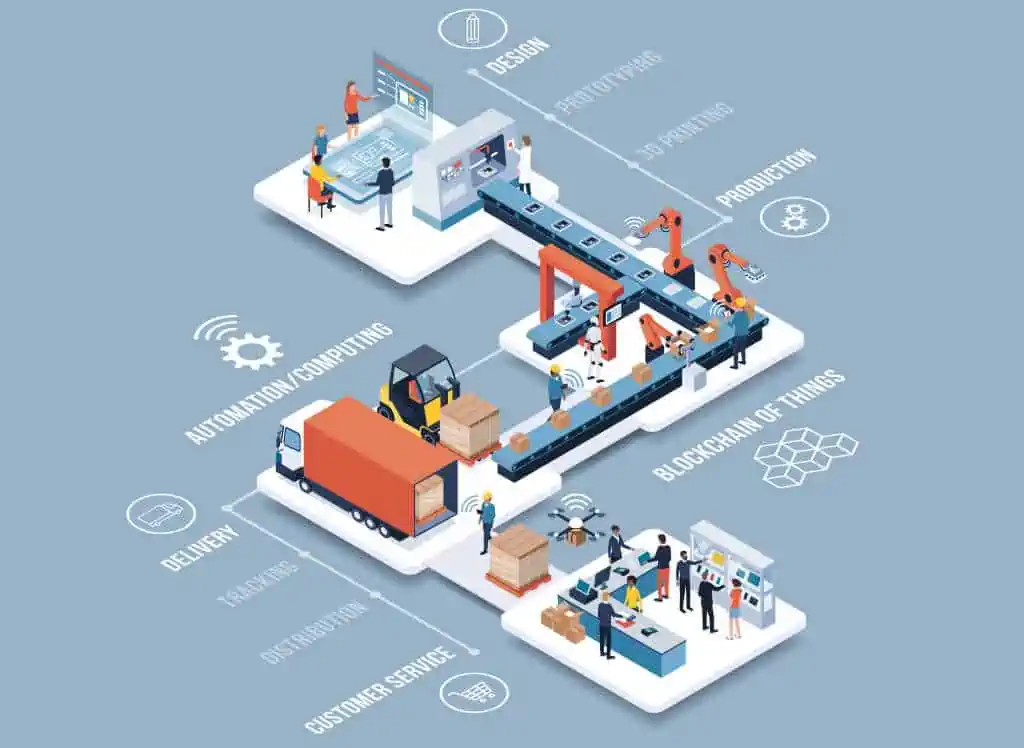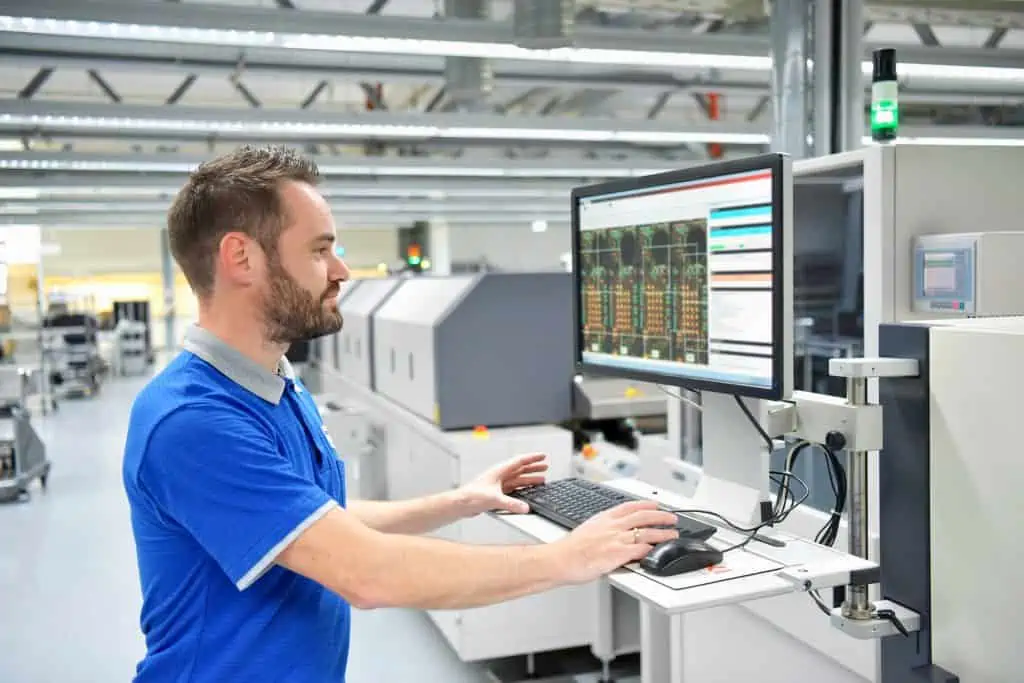The manufacturing sector is undergoing a period of profound change characterized by dramatic, technology-driven productivity gains. In this article, we examine the practical ways in which companies today are using new technologies to increase productivity and gain competitive advantage for their production lines.

At the very least, recent years have shown how important productivity and efficiency are to the manufacturing sector. Between supply chain disruptions, fluctuating demand, economic uncertainty, labor shortages, manufacturers have had to contend a record shortage of unfilled jobs, cyber threats, and an increasing focus on environmental, social, and governance. The solution, according to Deloitte analysts, is for manufacturers to embrace digital technology adoption.
Manufacturers looking to capture growth and protect long-term profitability should embrace digital capabilities from corporate functions to the factory floor.
Deloitte.
In short, when it comes to the question of how to improve productivity in the manufacturing industry, software plays a pivotal role — here are just a few ways you can apply it within your own production line.
Streamlining workflows with automation
Technology and software simplifies tasks by automating them. For an assembly line, an improvement can look like:
- Scanning barcodes instead of typing product codes into a spreadsheet by the worker. Or, to a more extend using RFID equipment or integrate real-time location data to even further reduce manual repetetive steps for your workforce.
- Setting reorder points for stock items that are then automatically reordered once they are depleted to a certain level.
- Repetitive yet precise work, such as welding, spray painting, or polishing being done by robots, as is common to increase manufacturing productivity.
A Manufacturing Execution System (MES) in its simplest form, is software that enables manufacturing companies to keep track of and monitor their machines, raw materials and goods. Since MES systems are integrated right into factory machinery, information is collected in real–time to keep track of production efforts. The data collected at the line form the basis to gain insight into manufacturing operations including resource use, production cycle time and scheduling conformance. By having an enforced process, steps are in place to make sure every comodity is produced to spec. For example, if a machine requires three parts to interlock, the machine knows to expect these three particular parts to fit in place and will not run if there are only two parts inserted or, more likely, the operator mis-positioned one of them.
Keen on learning more about how material flow planning will leverage your automation efforts? Follow this blogpost: Material flow planning to optimize logistics, production, and storage
Connecting the workforce
Imagine if your sales team didn’t know crucial information such as how much stock was available in the warehouse, a customer’s order history, or product lead times, they could miss out on valuable sales opportunities. Productive employees need access to business information and their team. It’s not just your production line that needs to be evaluated and inspected on a regular basis. The work processes of employees inside and outside the factory must also be constantly monitored and revised. Enterprise resource planning software is probably the best place to start in this regard.

Compared to an MES, manufacturing ERP software is designed to optimize business performance by providing reports on business operations and identifying where processes can be streamlined. An ERP can perform the following tasks:
- An ERP gives you accessibility to all business operational data through only one system.
- While ERP systems may not be integrated with machines on the shopfloor, but they collect information from them to ensure they run effectively and in sync with business processes.
- They provide an overview of raw materials to allocate resources accordingly and maximize productivity and cost efficiency.
Always remember: It's not just the data that makes the difference. Data only becomes information when it can be perceived by your employees. More on this topic: 3D visualization as a thinking tool within the company
Leveraging Manufacturing Analytics Software
Manufacturing generates immense amounts of data that can provide a wealth of insights if you know where to look and what to look for. Analyzing the data generated within a digitized assembly line reveals opportunities and risks. Predictive analytics can help with inventory planning, waste reduction and demand forecasting, for example. The challenge here is volume. We are talking about tens or even hundreds of gigabytes of data generated every day. A data scientist, regardless of their level of experience, needs business intelligence software to analyze this amount of information.
- BI tools provide information about current trends and performance, which can help manufacturers to identify areas where they need to make changes.
- Additionally, BI tools can help manufacturers spot new opportunities in the market and make better decisions when it comes to modifying product designs.
- Guided by the expertise of human analysts, the software can then categorize the data in real-time, allowing your organization to focus on creating tangible value instead of becoming mired in junk data.
How does it improve productivity? Data analytics for manufacturing is the only way to turn huge volumes of data into useful insights. You can create an interactive dashboard presented at the assembly line or generate static reports to share with stakeholders.
If you want to see some examples of how your factory's digital model can be used in BI projects, check out these blogposts: + FHNW – Process Mining for material flow analysis in teaching + Material flow analysis in two dimensions + Sankey diagram benefits for factory layout planning
Improving maintenance and reduce downtime
Even in a single assembly line, there are a large number of moving parts and complex appliences that require regular management and maintenance. When a machine breaks down unexpectedly, it results in reduced performance or – in the worst case – costly downtime.
Proactive maintenance goes a long way toward preventing this nightmare scenario. By combining maintenance software and sensors, your team gets a comprehensive view of the performance of every asset in your factory, down to the individual components. As soon as the software detects that something is wrong with a component, it can be replaced, significantly reducing the likelihood of machine failure.
Tracking down failure issues (defective component, human error, design problem, test problem, false alarm) is necessary to understand the true reason for any failure. A report from the automated test equipment is supplemented by feedback from the production line worker who actually solved the issue.
A predictive maintenance strategy, where repairs are made before a breakdown, has been shown to reduce breakdowns by up to 75 percent compared to a traditional reactive maintenance plan that keeps production lines running.
Reducing waste by optimizing quality assurance
Quality control is arguably one of the biggest impediments to manufacturing productivity. Failure to apply consistent quality control measures throughout the production process results in a significant loss of resources. Any faulty, damaged or defective product that leaves the production line will either result in rework or simply losses as the product is written off as waste.

Even for manufacturers with standardized quality assurance, the process can prove to be a bottleneck if it relies solely on manual inspection. A combination of robotics and quality management software is more cost-effective, efficient and accurate. This is not to say that worker intervention is completely irrelevant. As always, it’s important to remember that automation and software work best when paired with human intelligence.
You can promote all of your quality and maintenance efforts by putting them in a graphical context of your shopfloor and giving your employees easy access to them. Want to learn more why this is beneficial, read this post: Who benefits from my factory model as a Digital Twin?
Increasing efficiency on production planning and scheduling
Employees can spend hours of their day searching through spreadsheets and large data sets for the information they need. Advanced planning and scheduling empowers managers and operators to actively manage jobs and increase production efficiency by visualizing real-time production data.
One of the biggest advantages of using production planning software is the ability to integrate production plans for the entire company. The plans of all departments are coordinated with each other to achieve your common goals. Every aspect of a product’s manufacture and distribution is cross-referenced in an instant, saving hundreds of man-hours just to adjust plans.
Revealing opportunities and uncovering risk
Simulation is the recreation of a dynamic process in a system using a model that can be experimented with in order to arrive at knowledge that can be applied to reality.

The predictive test of a plant’s daily program provides information about the necessary provision of personnel and operating resources, about order throughput times and about the capacity utilization of the plant. For example, different order sequences, batch sizes or machine occupancy can be verified in advance of daytime operation. The simulation provides key figures that can be used to assess the quality of the solution. In this way, the best solution can be sought even before the start of production.
Carrying out these investigations on the real system would take a lot of time and cause high costs. Changes to the system, on the other hand, can be made easily in the planning phase using the simulation model and without influencing ongoing operation. Be aware that building simulation models and conducting studies is more or less a task that requires not only tools, but also raw data, interpreted data, and a lot of expertise – a full-time job that not every SME can do with its own workforce.
If you want to learn more about the benefits, but also the potential stumbling blocks, in using simulation studies, read our blog post Simulation for Production Planning – Questions and Answers
Planning in advance
While most of the aforementioned tools enable the operator to run a production facility, avoid downtime, and respond to unknown disturbances, they only help keep the facility running at its previously defined limits.
90% of the costs of a production line are determined at its early planning stages: during concept and design.
Improvements at this stage result in tremendous long-term benefits. You can shorten time-to-market for your products by identifying conflicts as early as the factory layout planning stage.
To improve production, you can optimize placement, performance, and maintenance to increase the output of your production equipment. Evaluate space and equipment design alternatives in a multidisciplinary design environment. Use clash detection to optimize space between the production process and the building structure. The logistical requirements and their control are significantly influenced by the layout. Good structures lead to better controllable assembly lines.

Layout planning solutions enable the creation of plant reports from your digital factory model that you can use throughout the life and operation of the plant. A well-designed digital twin of your production line will support all of the above initiatives.
A user-friendly system with the functionality they need drastically improves communication, agility and the speed at which tasks can be completed.
No problem, simply subscribe to our Blog-News!



